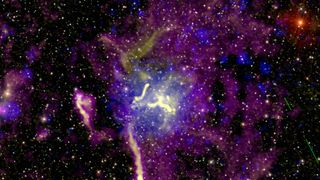Turbulent 'cosmic web' binds cluster of galaxies in new radio telescope images
When astronomers imaged the distant galactic cluster Abell 2255 in unprecedented detail, they found hints of powerful physical phenomena.

New images capture the radio glow from a distant cluster of galaxies in unprecedented detail, which could help shed light on the "cosmic web" of glowing, hot plasma gas and magnetic fields between galaxies.
Scientists think the hot plasma within clusters of galaxies contain shocks and turbulence that are created when galaxies within the cluster violently merge. This turbulence gives kinetic energy to electrons, causing them to move at speeds approaching that of light — also known as relativistic speeds. When these electrons are trapped by magnetic fields, the electrons are forced to travel in circular paths, causing them to emit so-called synchrotron radiation. These radio emissions should extend from cluster centers for millions of light-years.
For the new images, an international team of scientists collected the observations of the galactic cluster Abell 2255 — located 1 billion light-years from Earth, in the constellation Draco — by combining data from thousands of radio antennas that make up the Low-Frequency Array (LOFAR) radio telescope. They found evidence of radio synchrotron emission distributed over very large scales of at least 16 million light-years.
Related: What's it like inside a massive galaxy cluster? Scientists used 196 lasers to find out.
For 18 nights, LOFAR focused on Abell 2255 and an area surrounding it spanning 18 by 18 light-years, which constitutes a region of the night sky equivalent roughly to the size of four full moons stacked two-by-two from our vantage point on Earth. This marks the first time astronomers have captured a radio emission from such a large area and for such a long period.
The new images of Abell 2255 are 25 times sharper than images taken with older radio telescopes, and with 60 times less noise (unwanted interference that masks the sought-after signal).

Though galactic clusters are the most densely populated regions of the universe, consisting of hundreds to thousands of galaxies, there are also fascinating physical phenomena occurring between this population. Between the galaxies of galactic clusters such as Abell 2255, there is gas consisting of high-energy particles and magnetic fields, the origins of which are uncertain. How these particles and the magnetic fields influence each other is also unknown.
Get the Space.com Newsletter
Breaking space news, the latest updates on rocket launches, skywatching events and more!
"Based on the new images and our calculations, we think that the radio emission from Abell 2255 has been generated during the formation of the cluster," research leader Andrea Botteon, an astrophysicist at the University of Bologna in Italy, said in a statement. Botteon added that the LOFAR observations of Abell 2255 represent the first time that radio-wave-generating processes have been studied a great distance from the center of a galactic cluster.
The pervasiveness of the radio emissions indicated that shocks and turbulence in the hot gas are efficiently transferring kinetic energy into relativistic particles and magnetic fields in a region that extends to the cluster's outskirts.
Botteon and his colleagues have also theorized about the physical interactions occurring between the hot gas of Abell 2255 and its magnetic fields.
"In our theory, we assume that the particles are accelerated by the enormous turbulence and shocks produced during the formation of the cluster," Botteon said. "In turn, these motions can also amplify the magnetic fields."
In addition to further studying Abell 2255, the team intends to turn LOFAR and other forthcoming telescopes, such as the yet-to-be-built Square Kilometer Array, at other galactic clusters. The aim will be to study these densely populated regions of space for increased periods to learn more about the cosmic web that connects galaxies within clusters.
The team's research was published Nov. 2 in the journal Science Advances.
Follow us on Twitter @Spacedotcom or on Facebook.
Join our Space Forums to keep talking space on the latest missions, night sky and more! And if you have a news tip, correction or comment, let us know at: community@space.com.

Robert Lea is a science journalist in the U.K. whose articles have been published in Physics World, New Scientist, Astronomy Magazine, All About Space, Newsweek and ZME Science. He also writes about science communication for Elsevier and the European Journal of Physics. Rob holds a bachelor of science degree in physics and astronomy from the U.K.’s Open University. Follow him on Twitter @sciencef1rst.
Most Popular

